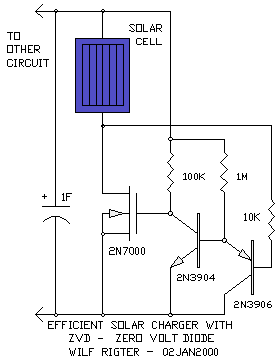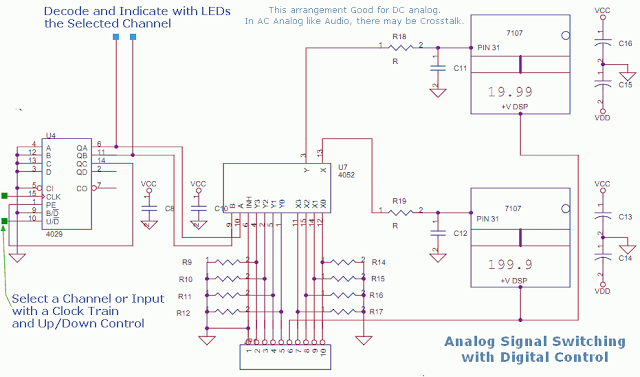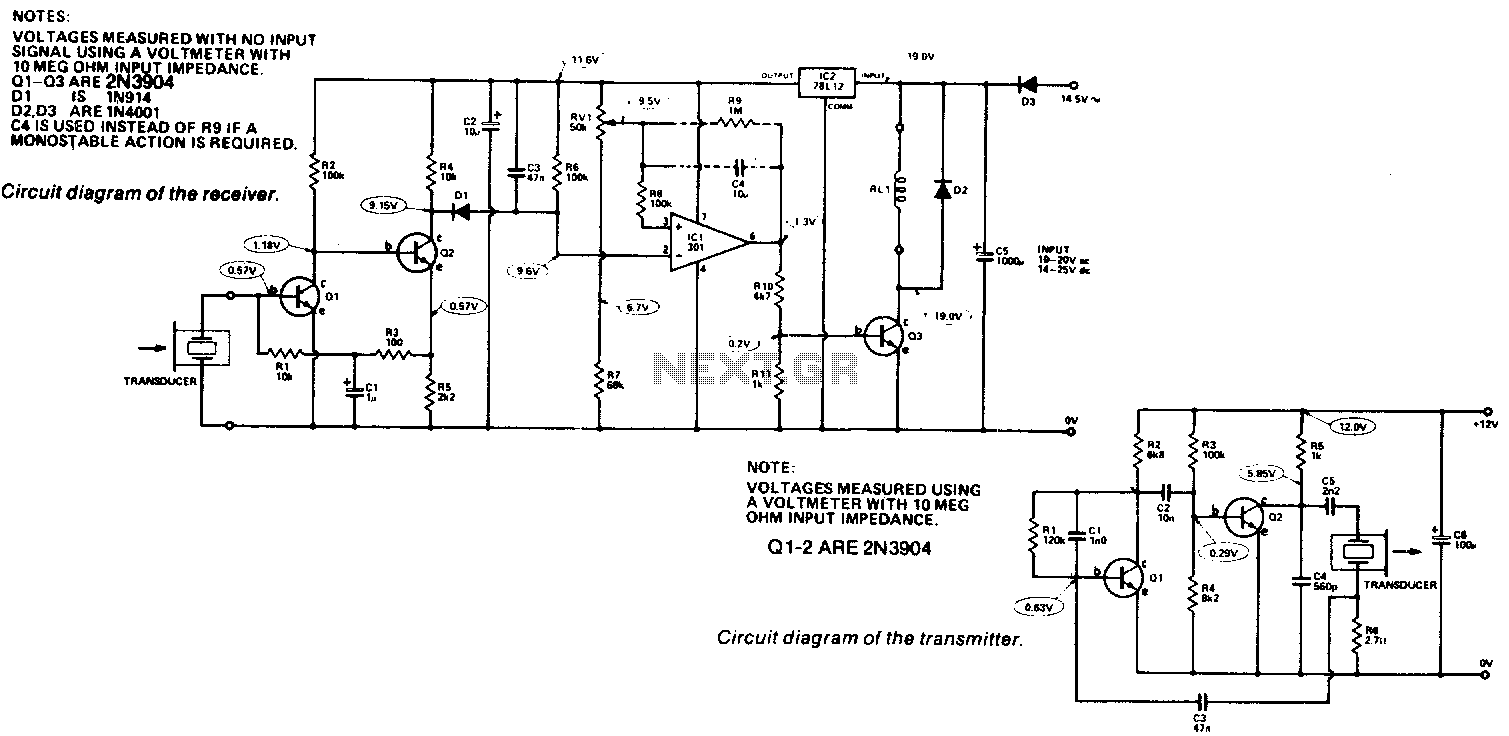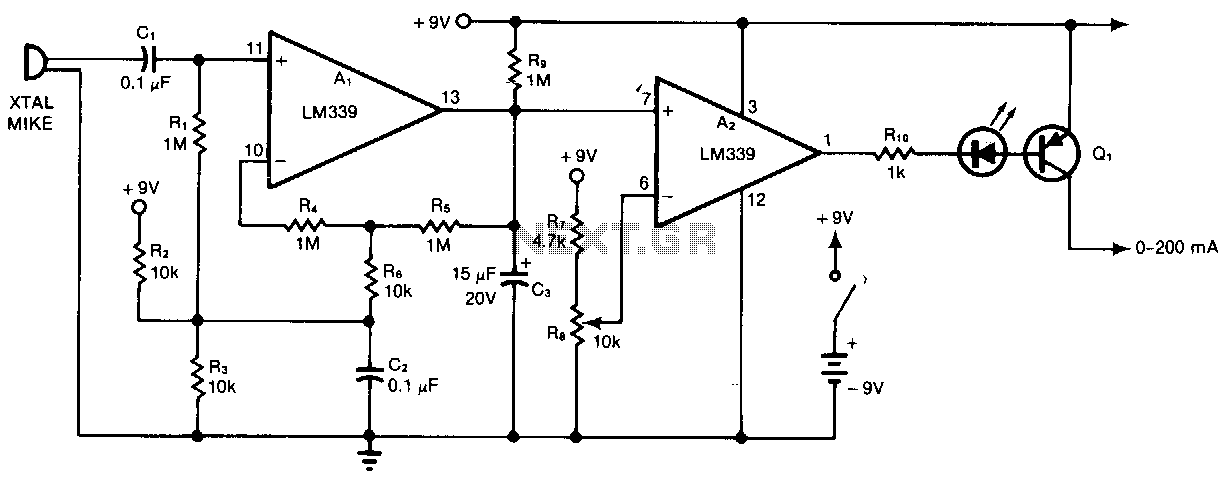
Sound Operated Switch
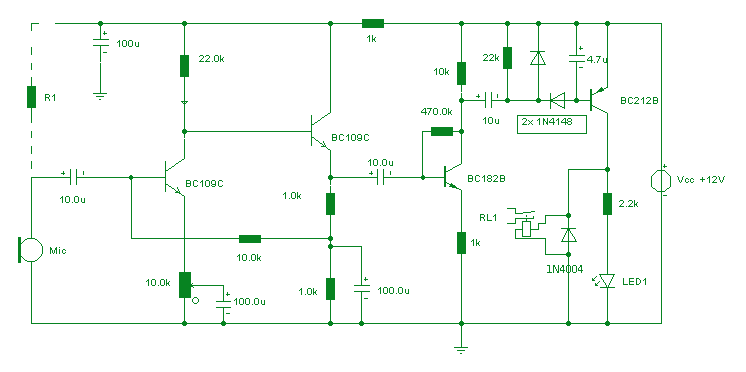
This sensitive sound operated switch can be used with a dynamic microphone insert as above, or be used with an electret (ECM) microphone. If an ECM is used then R1 (shown dotted) will need to be included. A suitable value would be between 2.2k and 10kohms. The two BC109C transistors form an audio preamp, the gain of which is controlled by the 10k preset. The output is further amplified by a BC182B transistor. To prevent instability, the preamp is decoupled with a 100u capacitor and 1k resistor.
The circuit described is a sound-operated switch utilizing a microphone as the input sensor. It can accommodate both dynamic and electret microphones, with a specific resistor (R1) required for the electret configuration to ensure proper operation. A resistor value between 2.2kΩ and 10kΩ is recommended for optimal performance, allowing for flexibility in sensitivity adjustments based on the microphone used.
The audio preamplifier stage consists of two BC109C transistors configured in a cascade arrangement to achieve a desired gain. The gain of the preamp is adjustable via a 10kΩ potentiometer, which allows for fine-tuning based on the environmental noise levels and the specific application requirements. This stage is crucial as it amplifies the low-level audio signals from the microphone to a usable level for further processing.
Following the preamplification, a BC182B transistor is employed to provide additional amplification, ensuring that the output signal is sufficiently strong for triggering the switch mechanism. To maintain stability within the circuit and prevent oscillations, a decoupling network consisting of a 100μF capacitor and a 1kΩ resistor is integrated into the preamp stage. This decoupling arrangement filters out high-frequency noise and stabilizes the power supply to the transistors, enhancing overall circuit reliability.
The output stage will typically interface with a relay or a similar switching device that can be controlled by the amplified audio signal. The entire assembly is designed to be sensitive to sound, allowing for activation by speech or other audio signals, making it suitable for various applications such as automatic lighting controls, sound-activated devices, or remote control systems. Proper layout and component selection are essential to ensure the circuit operates effectively within its intended environment.This sensitive sound operated switch can be used with a dynamic microphone insert as above, or be used with an electret (ECM) microphone. If an ECM is used then R1 (shown dotted) will need to be included. A suitable value would be between 2.2k and 10kohms. The two BC109C transitors form an audio preamp, the gain of which is controlled by the 10k preset. The output is further amplified by a BC182B transistor. To prevent instability the preamp is decoupled with a 100u capacitor and 1k resistor. The audio v 🔗 External reference
The circuit described is a sound-operated switch utilizing a microphone as the input sensor. It can accommodate both dynamic and electret microphones, with a specific resistor (R1) required for the electret configuration to ensure proper operation. A resistor value between 2.2kΩ and 10kΩ is recommended for optimal performance, allowing for flexibility in sensitivity adjustments based on the microphone used.
The audio preamplifier stage consists of two BC109C transistors configured in a cascade arrangement to achieve a desired gain. The gain of the preamp is adjustable via a 10kΩ potentiometer, which allows for fine-tuning based on the environmental noise levels and the specific application requirements. This stage is crucial as it amplifies the low-level audio signals from the microphone to a usable level for further processing.
Following the preamplification, a BC182B transistor is employed to provide additional amplification, ensuring that the output signal is sufficiently strong for triggering the switch mechanism. To maintain stability within the circuit and prevent oscillations, a decoupling network consisting of a 100μF capacitor and a 1kΩ resistor is integrated into the preamp stage. This decoupling arrangement filters out high-frequency noise and stabilizes the power supply to the transistors, enhancing overall circuit reliability.
The output stage will typically interface with a relay or a similar switching device that can be controlled by the amplified audio signal. The entire assembly is designed to be sensitive to sound, allowing for activation by speech or other audio signals, making it suitable for various applications such as automatic lighting controls, sound-activated devices, or remote control systems. Proper layout and component selection are essential to ensure the circuit operates effectively within its intended environment.This sensitive sound operated switch can be used with a dynamic microphone insert as above, or be used with an electret (ECM) microphone. If an ECM is used then R1 (shown dotted) will need to be included. A suitable value would be between 2.2k and 10kohms. The two BC109C transitors form an audio preamp, the gain of which is controlled by the 10k preset. The output is further amplified by a BC182B transistor. To prevent instability the preamp is decoupled with a 100u capacitor and 1k resistor. The audio v 🔗 External reference
